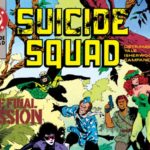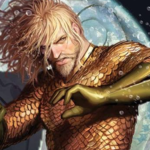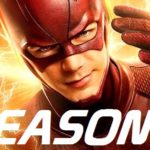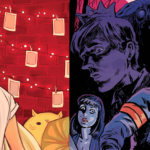
This last volume of Ostrander’s Suicide Squad collects issues #59-#66. Between Superman breathing down their necks and copycat Suicide Squads causing trouble, the stakes are appropriately high. If you missed out on the last entry, check it out here first.
The Mystery of The Atom
Issues #59-#62 concludes the mystery surrounding the death of The Atom, a.k.a. Ray Palmer. Also at the center of this story arc is Marlo, the former President of Qurac. If you’re confused as to whether the Marlo who appears here is the same one who appears in the first issue, don’t be—they’re both drawn differently. However, the story establishes that this is, in fact, the same Marlo from Issue #1, and he’s attracted the attention of quite a few different parties.
Over the course of Suicide Squad, a number of different superhero teams have been introduced. One of the teams I am most excited to see return is the Hayoth from Suicide Squad #45. Their first appearance showcased some of the relationship quirks they have with one another and, hilariously, nothing has changed since then. Dybbuk, the Hayoth’s artificial intelligence, is still forever pondering ethics while Ramban continues to deliberate over religious and philosophical musings, both to the frustration of Colonel Hacohen. Also making a return is The Jihad, though significantly weakened. This time they’re working for The Cabal, a rogue U.S. government intelligence agency. Once the big bad for The Squad, The Jihad is now a shadow of its former self and are quickly taken care of by Nemesis.
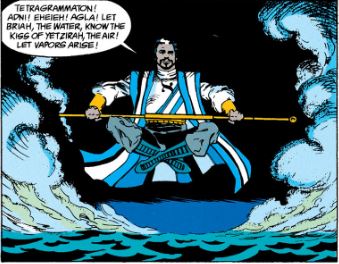
This story arc also develops a couple subplots I have been enjoying so far, as well. Of all the Squad members, Count Vertigo’s subplot has struck me the most. Aside from his struggles with bipolar disorder, Vertigo’s been previously manipulated into becoming a revolutionary symbol through forced drug use, then subsequently mind-controlled by Poison Ivy. Put simply, he has not been in full control of his own body for a long time. When Simon LaGrieve informs him that he no longer suffers from bipolar disorder, it puts Vertigo in an interesting position. Will he reclaim his own sense of self or will he continue his violent tendencies and kill Poison Ivy?
The biggest disappointment is the Ray Palmer mystery. Other than seeing Batman and Superman both flexing their respective expertise in detective and journalism work, the Justice League just isn’t that interesting here, and it’s clear that they were shoehorned in due to low sales at the time. I also wasn’t too fond of how Adam Cray, the imposter Atom, was treated here. His resentment towards Deadshot for killing his dad, Senator Cray, would have been an interesting way to address Floyd’s propensity to shoot first and ask questions later. Instead, what we get is a disappointing red herring.
The Final Mission

This closing story arc has all the familiar markings of a solid Suicide Squad story. There’s overseas political intrigue, plans gone awry, and D-list supervillains being put into impossible situations. But more fittingly, Waller and the Squad face off against a couple copycat teams. One of them goes so far as to call themselves Task Force X. Over the course of the series, the Squad has failed more often than not. They may accomplish what they set out to do for any given mission, but lives are often lost or compromised. The fact that Waller’s Suicide Squad has inspired others to take the concept further weighs heavy on her mind. In an act of redemption, Waller freely accepts a mission to help take down a ruthless dictator on the island of Diabloverde.
Waller’s redemption arc has been building ever since she turned herself in during Suicide Squad #39, and it comes to a satisfying conclusion here. The Squad has had their fair share of mishaps, and have even critically failed at times. Any successful missions are not without their caveats either. But at the end of a mission, it’s Waller who is responsible for all of it, including the deaths. When she finds Guedhe, Diabloverde’s dictator, Waller uses her intel to help give him what he wants: A peaceful death. It’s a clever way of subverting all the death and violence in the series, and it gives Amanda Waller’s character arc a satisfying closure.

Aside from the stuff with Waller, there’s still plenty of good ol’ fashion Suicide Squad shenanigans. Though this is the end of their run, Ostrander and Yale plant a few different plot seeds that should be fun to explore in the future. Of these, Dybbuk’s sudden marriage to another artificial intelligence brought a smile to my face. This, along with Ramban’s happy approval despite Colonel Hacohen nearly bursting a blood vessel, offers some much needed levity. Certain subplots are also given closure, such as Count Vertigo’s deal with Deadshot. Instead of having Deadshot kill him, Vertigo decides he’d rather live with his newfound peace of mind. This happens on the last page, and it’s a poignant way to end a series with “Suicide” in its title.
And with that comes the end of John Ostrander and Kim Yale’s epic Suicide Squad. The concept of the Suicide Squad will always be expendable D-list supervillains doing the government’s dirty work. It’s a fun idea, but what sets Ostrander’s run apart from other iterations is his focus on the human side. Suicide Squad takes us beyond the superhero beating the supervillain and into Belle Reve. We learn who these weird supervillains are and why they dress in tacky outfits and fight superheroes. More importantly, we’re reminded that Suicide Squad members are not just cannon fodder but are expendable if necessary. Who decides that is up in the air, but the Suicide Squad wouldn’t be the Suicide Squad without a little moral ambiguity now and then. Here’s to hoping that James Gunn’s The Suicide Squad captures some of that magic.

